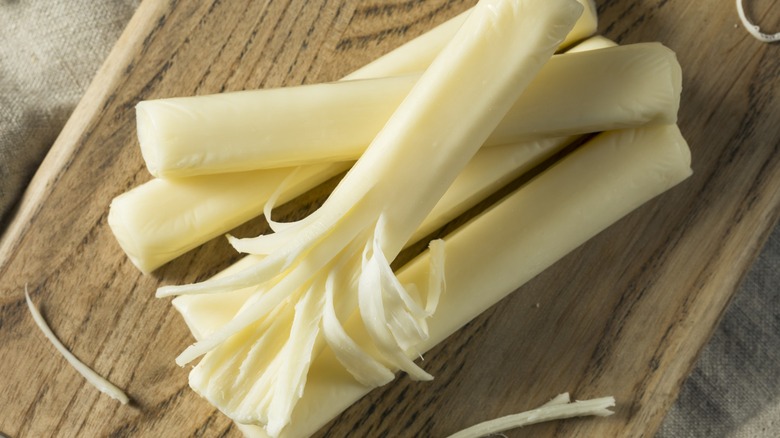The Reason String Cheese Must Always Be Mozzarella
String cheese gives us a chance to play with our food, which is a solid reason to love it no matter what age you are. But have you ever stopped to question why this tasty snack can be pulled into tendrils quite so effectively, and why you never see these packages containing other cheeses like cheddar or provolone? It turns out that string cheese is only ever made from mozzarella, which is why it's always white. You may find cheese sticks made from other cheeses, of course, but you won't be able to pull them apart in quite so satisfying a way.
In short, mozzarella is the only type of cheese that can produce stringiness. Thankfully, this element doesn't come from additives that warp the original qualities of the cheese curds — these packages typically contain real cheese. During the mozzarella-making process, curds are heated and morphed together, which causes the casein proteins to line up horizontally and naturally create that peel-able quality. This alignment is also essential for stretchiness (which we see when eating pizza and mozzarella sticks). Basically, what's happening is the casein proteins are repeatedly separating and re-forming as you pull the cheese apart.
The difference between fresh mozzarella and string cheese
Once the basis of mozzarella is made, the cheese can go in two different directions: It can be kept moist in water or a briny liquid, or it can be dried to make stringy sticks (or bags of the shredded stuff). The former is much more finicky than the latter, as over half of its content is made up of water, it's typically made from whole milk, and it will generally only stay fresh for a week in the fridge — although if you're eating it the same day you bought it, you may want to keep your mozzarella at room temperature for ideal taste and texture. If you see balls and pearls of fresh mozzarella, this typically means that the cheesemakers have molded the heated curds into these shapes.
String cheese takes these curds one step further. Once they're heated, they continue to be stretched by machines (or by hand in some cases), which lines up the proteins even more and enhances that pull-apart quality — hence why processed mozzarella can be better for melting. The process goes like this: The hot curds are folded into ropes and stretched, and then these steps are repeated until they turn into strings. Finally, they're molded into the stick shape we see in bags, left to dry, and packaged without a water bath.

